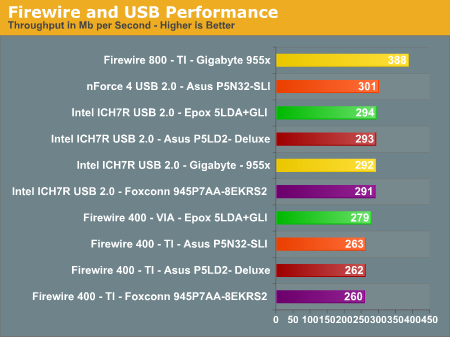Intel 945P Motherboards: Going from Hopeless to Enthusiastic
by Gary Key on November 15, 2005 12:02 AM EST- Posted in
- Motherboards
Firewire and USB Performance
After looking at many options for Firewire and USB testing, we determined that an external USB 2.0, Firewire 400, and Firewire 800 hard disk might be a sensible way to look at USB and Firewire throughput.
Our first efforts at testing with an IDE or SATA drive as the "server" yielded very inconsistent results, since Windows XP sets up cache schemes to improve performance. Finally, we decided to try a RAM disk as our "server", since memory removed almost all overhead from the serving end. We also managed to turn off disk caching on the USB and Firewire side by setting up the drives for "quick disconnect" and our results were then consistent over many test runs.
We used 1GB of fast 3-2-2-8 or 4-4-4-15 system memory set up as a 450MB RAM disk and 550MB of system memory. Our standard file is the SPECviewPerf install file, which is 432,533,504 bytes (412.4961MB). After copying this file to our RAM disk, we measured the time for writing from the RAM disk to our external USB 2.0, Firewire 400, or Firewire 800 drive using a Windows timing program written for AnandTech by our own Jason Clark. The copy times in seconds were then converted into Megabits per second (Mb) to provide a convenient means of comparing throughput. Higher Rates, therefore, mean better performance in this particular test.
Our test is just one of many throughput tests, but in this benchmark, it is clear that the VIA Firewire 400 chip is faster than TI's 1394a chip. The NVIDIA nForce4 USB 2.0 controller is slightly faster than Intel's solution.
After looking at many options for Firewire and USB testing, we determined that an external USB 2.0, Firewire 400, and Firewire 800 hard disk might be a sensible way to look at USB and Firewire throughput.
Our first efforts at testing with an IDE or SATA drive as the "server" yielded very inconsistent results, since Windows XP sets up cache schemes to improve performance. Finally, we decided to try a RAM disk as our "server", since memory removed almost all overhead from the serving end. We also managed to turn off disk caching on the USB and Firewire side by setting up the drives for "quick disconnect" and our results were then consistent over many test runs.
We used 1GB of fast 3-2-2-8 or 4-4-4-15 system memory set up as a 450MB RAM disk and 550MB of system memory. Our standard file is the SPECviewPerf install file, which is 432,533,504 bytes (412.4961MB). After copying this file to our RAM disk, we measured the time for writing from the RAM disk to our external USB 2.0, Firewire 400, or Firewire 800 drive using a Windows timing program written for AnandTech by our own Jason Clark. The copy times in seconds were then converted into Megabits per second (Mb) to provide a convenient means of comparing throughput. Higher Rates, therefore, mean better performance in this particular test.

Our test is just one of many throughput tests, but in this benchmark, it is clear that the VIA Firewire 400 chip is faster than TI's 1394a chip. The NVIDIA nForce4 USB 2.0 controller is slightly faster than Intel's solution.










26 Comments
View All Comments
Houdani - Tuesday, November 15, 2005 - link
The other reviewers here at Anandtech offer their own style, thereby providing the "mix it up" factor. I personally don't think you need to adjust your style, as I happen to like the cultural infusion supplied by your literary quotes.Furen - Tuesday, November 15, 2005 - link
Fair enough, I was just giving my personal opinion on the matter.bersl2 - Tuesday, November 15, 2005 - link
What's wrong with being exposed to what the author believes to be wisdom? Surely you don't read these articles simply for the technical specifications; otherwise, you would read the spec sheet. Why, then, do you object to the author trying to relate an idea to you?Furen - Tuesday, November 15, 2005 - link
I read the articles for their technical merits. Spec sheets do not show how the different components interact with one another nor can they show performance, stability, etc; and, most importantly of all, they're made by the manufacturer, who is hardly to be considered an unbiased source. The problem with throwing a strong idea in front of the reader before giving him article is that this idea becomes the filter through which the rest of the article is viewed. This is, of course, very effective if you are trying to persuade the user to reach the same conclusions as you, but it skews the reader's ability to analize the purely technical merits of the products.mbhame - Tuesday, November 15, 2005 - link
What makes you so sure Conroe is the last P4? ;)JarredWalton - Tuesday, November 15, 2005 - link
Conroe isn't a P4. It's the next generation architecture that Intel has not yet named - also referred to as the NGATIHNYN. :p